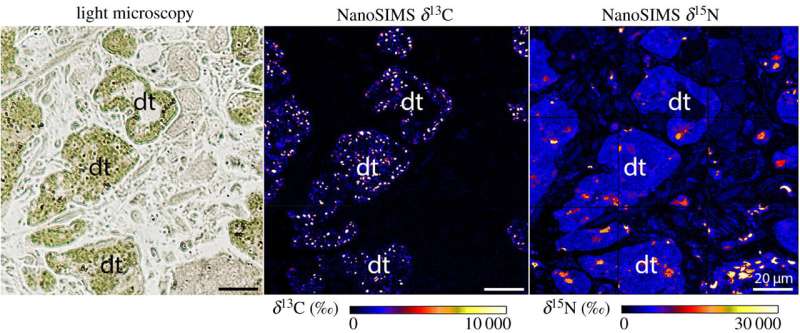October 14, 2021 report
Evidence found of sea slugs stealing photosynthesizing machinery from algae, using it to boost reproduction

A team of researchers affiliated with multiple institutions in Portugal and France has found evidence suggesting that sea slugs that steal photosynthesizing machinery from the algae they eat use it to boost their own reproduction efforts. In their paper published in Proceedings of the Royal Society B, the group describes their study of the unique creatures and what they learned about them.
Prior research has shown that some kinds of sea slugs retain photosynthesizing machinery (chloroplasts) from the algae they eat and then store it in their own bodies for long periods of time—sometimes for as long as a year. And remarkably, during the storage period, the chloroplasts remain functional. Prior research has also shown that the sea slugs draw energy from the chloroplasts; after installing them in their own bodies, they cease eating. The process, known humorously as kleptoplasty, has led the little creatures to be described sometimes as "solar powered slugs." In this new effort, the researchers suggest that the slugs retain chloroplasts for another reason—to boost their reproductive efficiency.
The researchers found that material produced by the gut-implanted chloroplasts made its way into reproductive tissue. That led to the slugs producing more eggs than their non-solar-powered cousins. They note that spawning for sea slugs is an energy-intensive endeavor. They are hermaphrodites, and mate by running their heads into one another. Each has a tiny penis that unspools from a position behind one of their eyes and inseminates the other. Each slug produces hundreds of eggs and each egg comes with its own nutrient pack. The chloroplast material appears to give the slugs a reproductive energy boost, which leads to the production of more eggs. More specifically, the researchers found that the slugs use material from the chloroplasts to produce polyunsaturated fatty acids in their reproductive organs, boosting their reproductive energy. The researchers note also that the process of making chloroplasts useful is a one-time event. There is no mechanism for integrating them so completely that they could be passed down to offspring.
More information: Paulo Cartaxana et al, Photosynthesis from stolen chloroplasts can support sea slug reproductive fitness, Proceedings of the Royal Society B: Biological Sciences (2021). DOI: 10.1098/rspb.2021.1779
Journal information: Proceedings of the Royal Society B
© 2021 Science X Network


















